Chinese soups can be heavy, filling and fiery, such as Chinese Hot & Sour Soup, or light, clean and cleansing, like this Chinese Daikon Soup. These kinds of everyday soups are simple to make, require just a handful of ingredients (in this case, four ingredients – actually, three, if you don’t want to use cilantro) and so good for you.
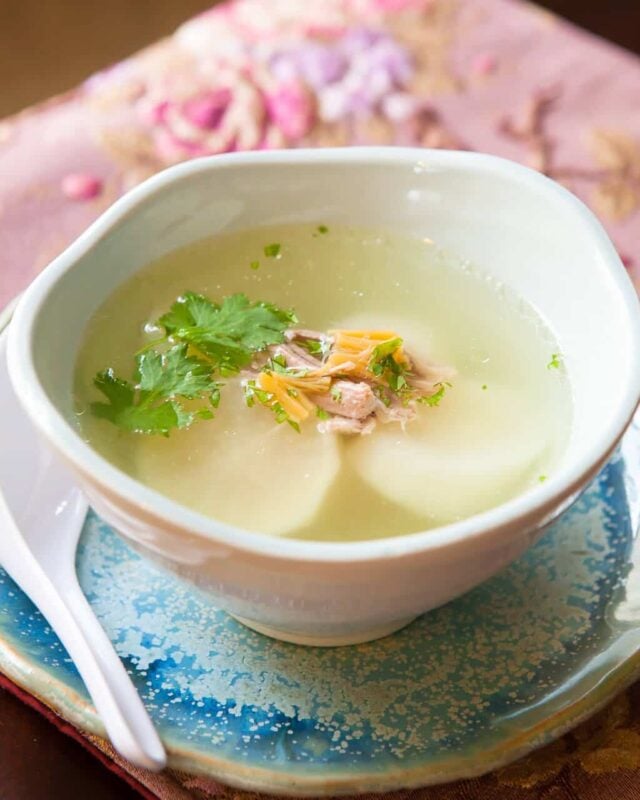
Why This Daikon Soup Is So Good
- Just 3 or 4 ingredients.
- A clear, clean broth (no gunk!)
- Use dried scallops for big flavor booster (optional.)
- Can make on stovetop or use pressure cooker.
Ingredients
- Pork
- Daikon
- Dried scallops (optional)
- Salt
- Cilantro (optional)
How To Make This Daikon Soup – Step By Step
- Par boil the pork as shown in photos, then rinse well to clean. In a large pot, add in the pork, daikon and scallops (if using), fill with 8-10 cups of water (depending on capacity of pot.)
- Pressure Cooker: Cook under pressure for 20 minutes
- Slow Cooker: Low 8 hours
- Stovetop: Bring to boil, then reduce heat to low, cover with lid, leaving a little gap for steam to escape and simmer for 2 hours (or more)
- Season with salt – start with 1 teaspoon, stir and taste. Garnish with cilantro, if desired.
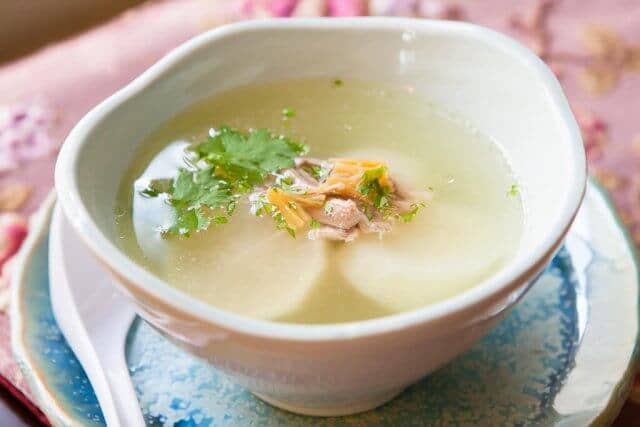
An Easy Soup
There are 2 essential ingredients to this soup: daikon and pork. An optional ingredient is dried scallops (we’ll talk more about that later) and garnish with fresh cilantro. At times, I like to also add carrots to the soup.
Clean, Clear Broth In Daikon Soup
Have you ever made meat or bone broth and seen white or grayish foam forming on top of the water? What is it? Well, it’s a combination of surface protein, dirt, minuscule bone fragments, fats, etc. All that stuff can make your broth cloudy and gritty.
For the best broth made from meat and/or bones, the raw meat must first be parboiled for a few minutes in order to remove all that “gunk.” I do this by bringing a large pot of water to a boil, then adding the bones/meat to the water and return to a hard, rolling boil for about 5-7 minutes.
The rollicking, harsh boiling water will give the meat a good wash and scrub, releasing particles, solidifying protein, loosening and bits that don’t belong in my clear broth. Then, I’ll drain the dirty water, give the meat or bones a rinse and start the broth afresh with clean water in the pot.
While all this does take an extra 15 minutes of your time, it’s absolutely worth the effort.
There’s a shortcut to this, especially if you’re only using chunks of meat to make the broth. We buy pork roasts when they are on sale, then cut them up into smaller-than-fist sized chunks to freeze and make soups.
Why meat vs. bone/meat? It’s just a preference. Lean meats make lean broths. If you’re watching your cholesterol and fat intake, use lean pork (or skinless chicken breast meat.)
Mom’s Shortcut
This shortcut shaves the parboiling time down from 15 minutes to just 3 minutes.
Bring a quart of water to a boil. My Mom has an electric hot water kettle. At my house, I just use the hot water directly from my instant hot water dispenser (which I can’t live without!).
Place the pork in a shallow bowl.
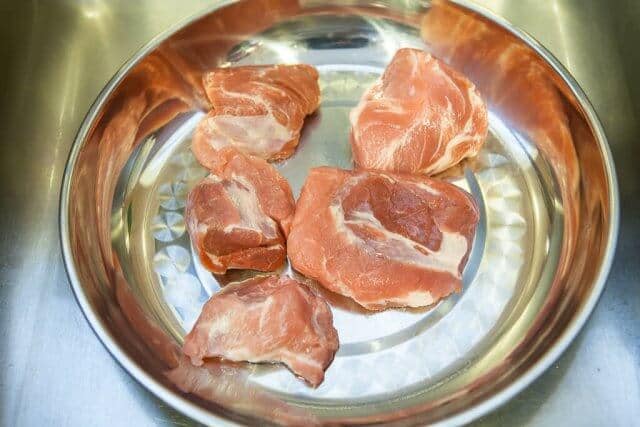
Pour just half of the boiling hot water on top of the pork.
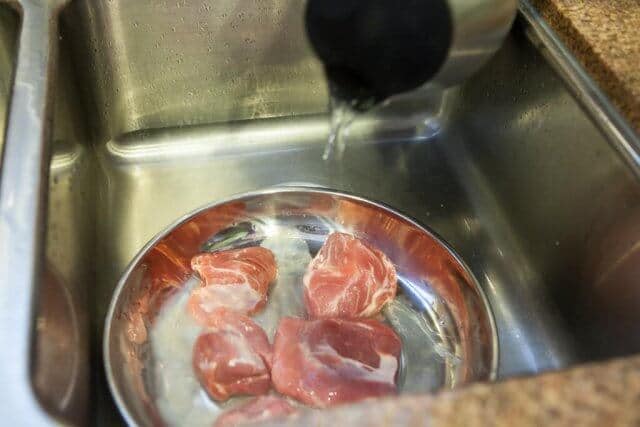
Give each piece of pork a jiggle in the boiling water. Turn the pork over.
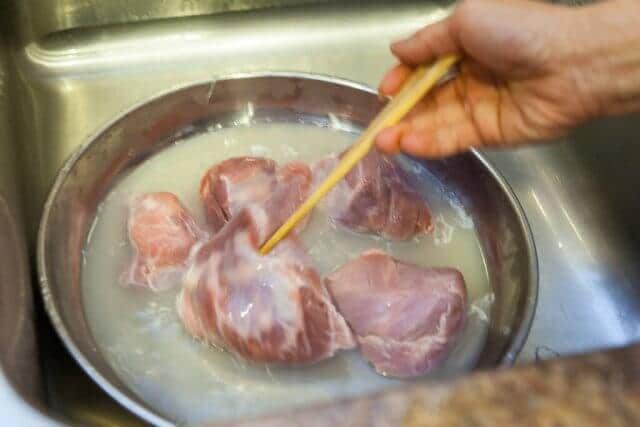
Drain and discard the cloudy water.
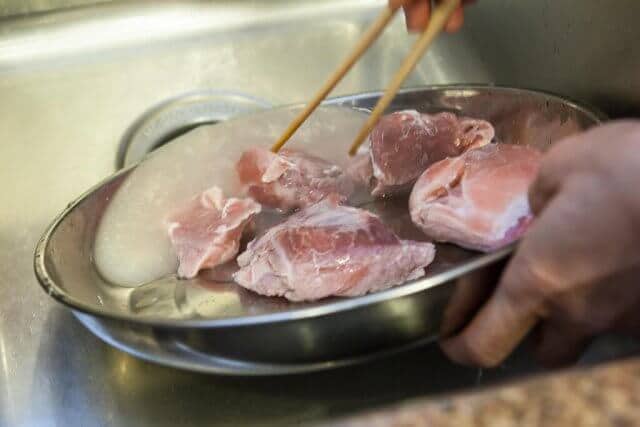
Pour the remaining half of the boiling water on pork again.
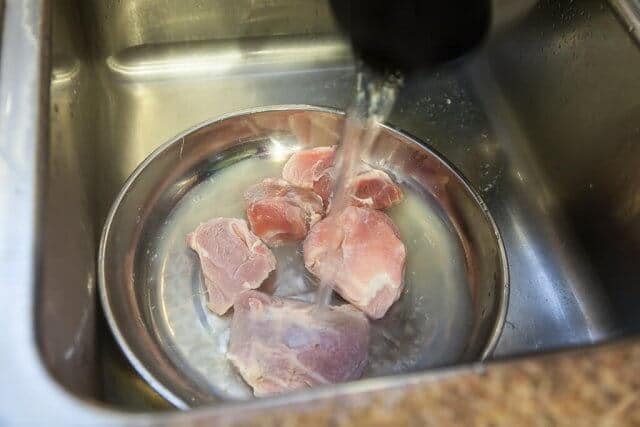
Give each piece a jiggle and wiggle and discard the cloudy, dirty water again.
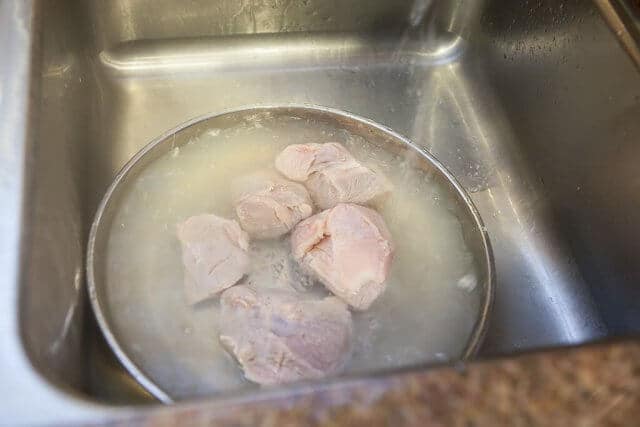
Final step: rinse the pork with cool water from the faucet. Now it’s clean, and ready for broth making.
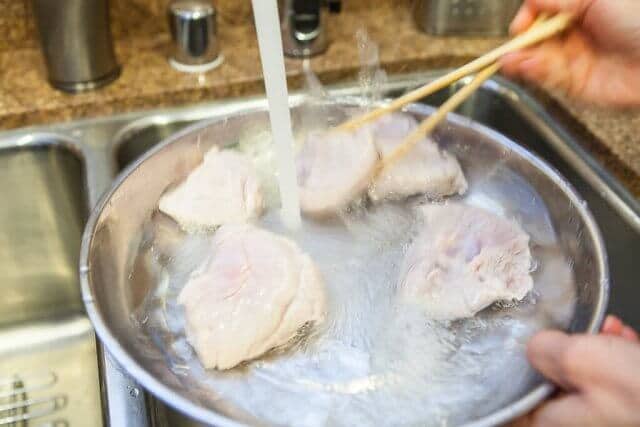
What is Daikon?
Daikon is white radish that’s mild and sweet in flavor when cooked, and delicate yet with a spicy kick when grated and eaten raw. In Asia, the daikon is used in so many ways: pickled, fried, simmered, stewed, grated, mashed and shredded. In Chinese cuisine, it’s most popular use is in soups, braised for hours with beef, or shredded to use in steamed and pan-fried daikon cake.
You’ve probably eaten it raw at Japanese sushi restaurants (they serve it in a finely shredded mount along with sashimi), or julienned and pickled with carrots at a Vietnamese restaurant.
They last quite a long time in the refrigerator. To store, I cut off as much green leaves as possible, wrap each daikon tightly in plastic wrap and store in crisper. They’ll last for at least one week.
To use, peel with vegetable peeler first, trim and discard the tip and end. To prepare for this Chinese Daikon Soup recipe, you’ll cut the daikon into chunks.
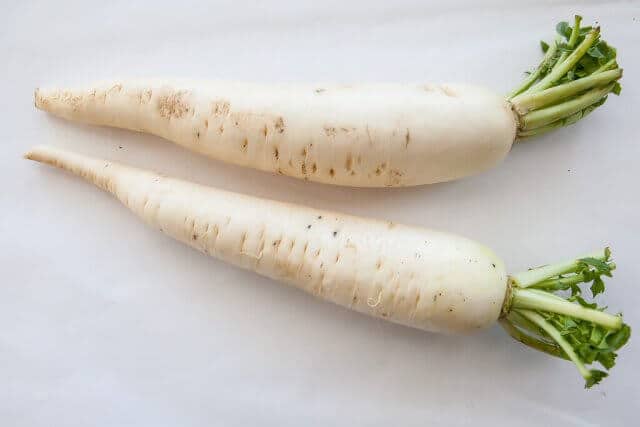
What Are Dried Scallops?
Our Daikon soup is made with pork broth and flavored with dried scallops if you have them. Dried scallops are expensive a little harder to find outside of Asian supermarkets, so it’s an optional ingredient. The dried scallops give the soup a big flavor boost of umami, but here are ingredient substitutions to add umami (deep, meaty, savory flavor):
- Dried Chinese or shiitake mushrooms (3-4 whole)
- Fresh Chinese or shiitake mushrooms (4-5 whole)
- Dried shrimp (1 tablespoon)
- Small chunk of salt-cured ham, like Virginia country ham (1-2 ounces)
Or – just leave it out! We’ve made this soup plenty of times without the expensive dried scallops or other flavor boosters.
If you are using dried scallops for soup, you can just rinse the scallops (gets rid of any dust) and plop them into your pot for soup. If you are using the scallops in a stir fry, you must soak the dried scallops in hot water for about 15-30 minutes before using (depends on how big the scallops are.) You can then shred the scallops with your fingers.
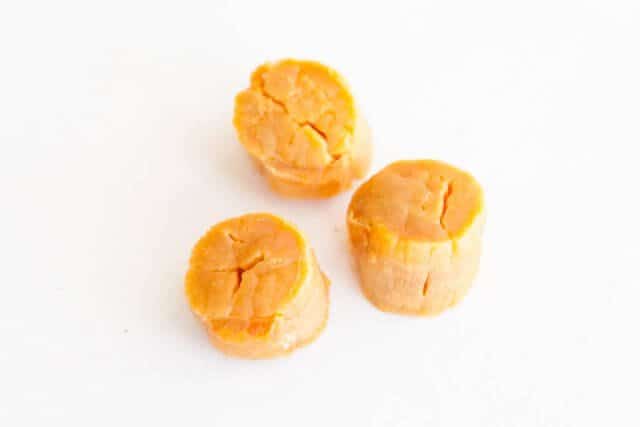
Top Tips For This Daikon Soup
- This Chinese Daikon Soup can be made in a pressure cooker, slow cooker or on the stove. Add all ingredients, fill with water and set to cook 20 minutes under pressure.
- We’re testing out the Ming Tsai Pressure Cooker that HSN sells – it’s such a popular item that it’s been sold out since the day it appeared on-air with Ming Tsai! I’ll write a separate review of the pressure cooker another time.
- After cooking under pressure, you can wait for the pressure to release naturally, or you can manually release it. I like using a thick terry kitchen towel and tongs.
- For the best broth made from meat and/or bones, the raw meat must first be parboiled for a few minutes in order to remove all that “gunk.”


Check Out These Other Great Soup Recipes!
- Malaysian Chicken Noodle Soup with Asian Greens and Chili-Soy Sauce
- Thai Chicken Coconut Soup (Tom Ka Gai)
- Vietnamese Pho Recipe: Beef Noodle Soup
- Pressure Cooker Ramen Noodle Soup
Have you tried this Daikon Soup recipe? Feel free to leave a star rating and I’d love to hear from you in the comments below!

Chinese Daikon Soup Recipe
Ingredients
- 1 pound pork
- 1 large daikon 10 ounces, peeled and cut into large chunks
- 4 dried scallops optional
- salt
- fresh cilantro for garnish optional
Instructions
- Par boil the pork as shown in photos, then rinse well to clean. In a large pot, add in the pork, daikon and scallops (if using), fill with 8-10 cups of water (depending on capacity of pot.)
- Pressure Cooker: Cook under pressure for 20 minutes
- Slow Cooker: Low 8 hours
- Stovetop: Bring to boil, then reduce heat to low, cover with lid, leaving a little gap for steam to escape and simmer for 2 hours (or more)
- Season with salt - start with 1 teaspoon, stir and taste. Garnish with cilantro, if desired.




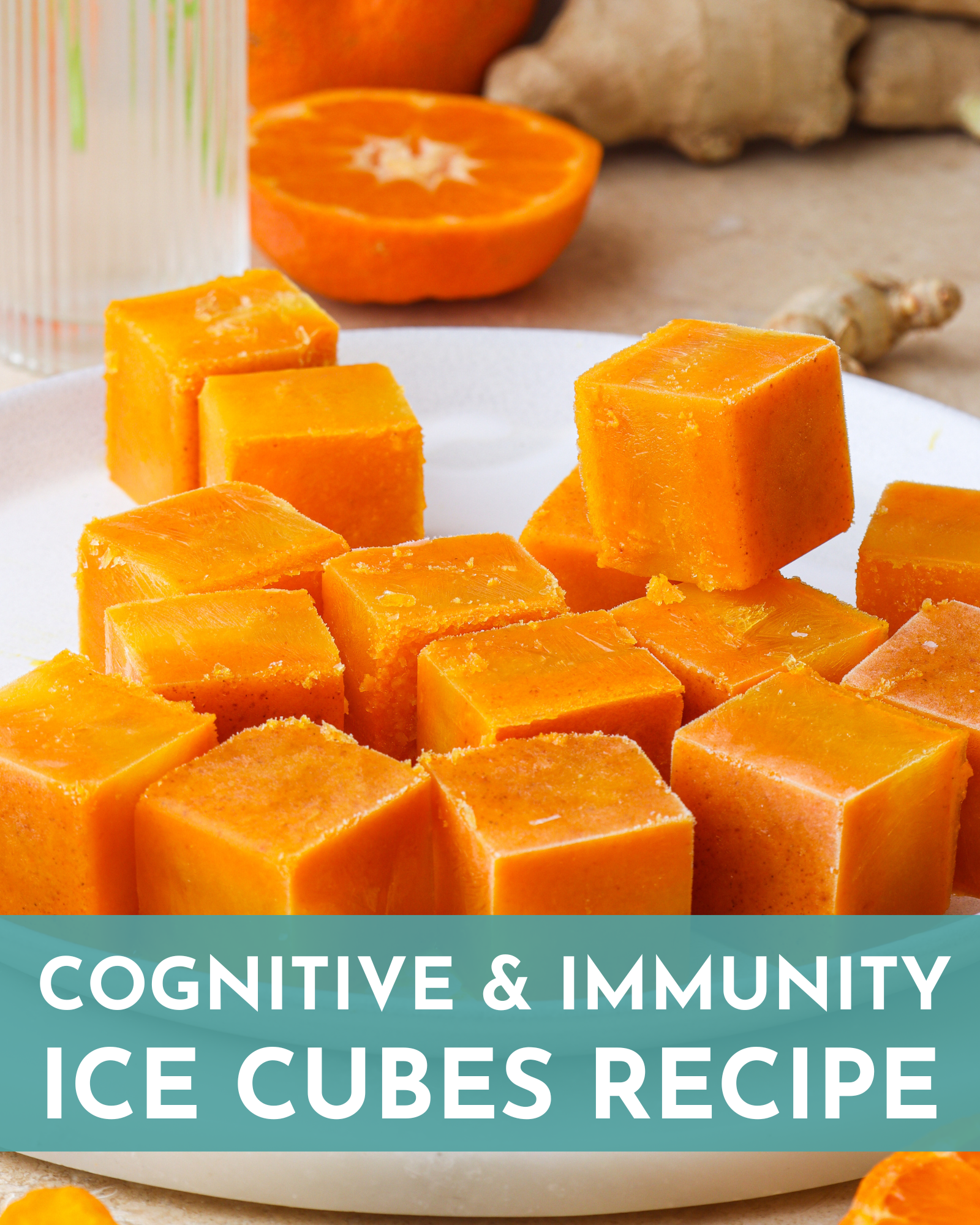

I don’t eat pork. I don’t like the taste of scallops.
If I were to substitute chicken or beef, do you think the soup would have a good taste?
Also, I don’t have a pressure cooker.
Is there something else I could use instead to successfully make this recipe??
Can I use a good pork broth? The farm where I get my pork has a lovely broth that has nothing added. I have the daikon, and scallops. The scallops are really small (I am sure will rehydrate larger) I can see about getting some pork bones but wondering if i have frozen pork stock if I could cut a corner. Again nothing added local pork broth.
this is a very nice and nourishing soup..its always perfect to be served hot..i enjoyed the previous time when i made this soup for the family..every step of making this soup is very important as you cant make a single mistake otherwise your soup wont taste nice, then the effort will be a waste..
My Family Loved it. I am definitely sharing Guys, Thanks For sharing this Great Recipe. this recipe and this website with my friend. Hope they also love it. Thank you again for sharing such a great recipe.
Love this soup, so nourishing,
Nice recipe. I will try it.
Hope it will turn out nice.
Thank you.
The Chinese Daikon Soup is the best….I thought I would just “try it” and if I didn’t like it “oh well”…it is going to be the soup of the month, that I will turn to quite a bit…..so “fair well tomato soup”….thank you for the excellent recipe…..
Great soup base. Have made this several times. By itself lovely and light. Add soy, ginger, oyster sauce, red pepper flakes, etc to layer deep and rich flavors. Who knew the radish was so versatile? Thanks
Thanks so much!! It’s my fav soup. Mom just made a pot yesterday and will be bringing it over this week. jaden
Looks very delicious. I would like to cook if I can collect all the ingredients. By the way, thanks for sharing.
I asked my wife to prepare this for me and it was delicious. Thanks for sharing!
Have you considered preparing your own meals? Life changing. Highly recommend.
Oh you don’t eat the pork with the soup?
You can, but the flavor of the pork has already been “spent” in soup. Sometimes, if I want more meat in soup to eat, I will just have some extra pork, sliced in thin strips, to add into soup a little later, when soup is almost done cooking.
If I am using a pressure cooker, I will release the pressure, add in the meat and stir. The heat in the pressure cooker is hot enough to cook the meat completely. I do this especially with chicken breast, to keep the chicken tender and flavorful.
Such a great tip about adding the meat near the end.
We still eat the meat off the bone and dip it with my homemade sauce (garlic, thai chilli pepper, sugar, fish sauce, lime, and cilantro). So good!
I wanted daikon soup but I wanted it fast. I’m cold. So I used mushroom dashi and dried baby shrimp for flavor, as well as a bit fish sauce. I julienned the daikon, added shredded cabbage, and leeks. As an afterthought, kaffir lime leaves went in and some lime juice. Tasted delicious and was fast to make. The little shrimp are cute with their little black eyes looking at you! Garnished with green onion, cilantro, and Thai chile. I definitely strayed from your recipe but thanks for the the inspiration!!
So, a completely different recipe turned out great. Woohoo!
Where can one find Daikon readily? Ive gone to my local and he hasnt got any and doesnt know where I could find it
Any Asian market will have daikon.
Great idea of a shortcut. Happy to know that I can cook it in any type of pressure cooker I want. Thanks!
Wow! I just noticed you can use a pressure cooker to make the broth. Overlooked it the first time. Thanks for such useful information. Got to give it to you! Your shortcut works like charm!
Hey Jaden, Awesome article. I tried it and it was delicious. Loved the cool new techniques.
What a warming and comforting soup! I have never used daikon or dried scallops before!
Delicious! Also added at end a few stalks of mustard greens for bright colour and extra nutrition. Can’t wait to make up another pot.
I love the ingredients. I love all the cool new techniques.
I’ve never cooked any Chinese food before so I’m looking forward to try this one out 🙂
Jaden I love the sound of this…will give it a try. When you say discard the meat do you not eat the pork or has it served it’s purpose and it’s meant to be thrown away?
I do not eat the meat, its flavor has already been spent. But I reserve the meat and shred it for the dogs 🙂
I tried “mom’s trick” this morning. I still had to skim the scum off though; did I do something wrong? The yucky stuff was less than usual, and it was less gray too, so this method is still worth it.
Can’t wait to have soup for lunch! Thanks, Jaden.
Hi Sharon! You’ll always get a little bit of scum on surface, but it should be drastically less than without the technique. Also, try simmering on lower heat when you’re making the soup. The grayish scum is what you DON’T want – and that’s mostly gone from the parboiling or rinsing.
So can I use Mom’s Shortcut with chicken breasts to make a clear chicken broth or should I stick to your method? Thanks for both.
Yes, you can use chicken breasts with this shortcut – we do all the time.
I didn’t know dried shitake adds umami flavor, I will try that next time. I usually use some bonito flakes with a sheet of kelp. I love daikon soup, been making it with beef but I don’t make it as often now because the recipe I use calls for fish sauce. I will definitely try this recipe it’s so simple and clean.
Meryll = You’ll love this recipe! I use bonito/kelp a lot for soups too – I especially like the bonito that’s packaged in mesh bags, ready for use.
Made this yesterday/last night (since I used slow cooker). Sooo awesome! I never would have thought about cooked daikon! Always use it raw. Thanks SK!!
Awesome! We are so happy you loved it! – SK Team
This sounds delicious!!! I was just curious since I do not eat pork, can I make this the same exact way with beef or chicken (or does it not work as well?)
Love your blog!!
Chicken would be perfect!
Wow. I am going to make this. Thanks
I love the ingredients. I love all the cool new techniques. Can’t wait to bone up on my Asian cooking- glad I found your blog!
I love the shortcut for parboiling the bones. Such a great idea! It’s cold and rainy here today so it’s the perfect soup weather. Looks so comforting and delicious!
You make it sound so easy. I’m going to make a marker run in the morning and give it a try. Wih me luck and thank you and your Mom.